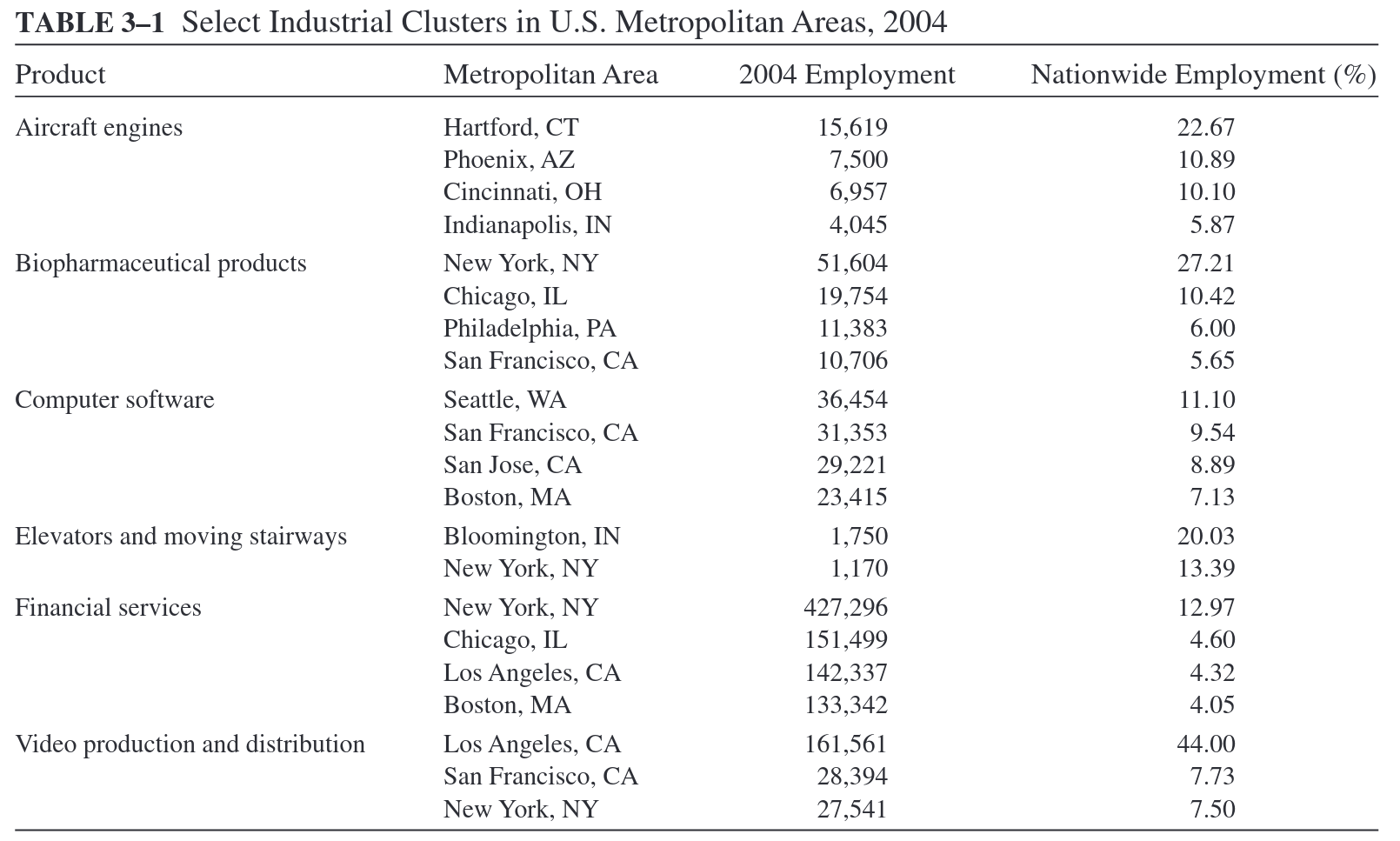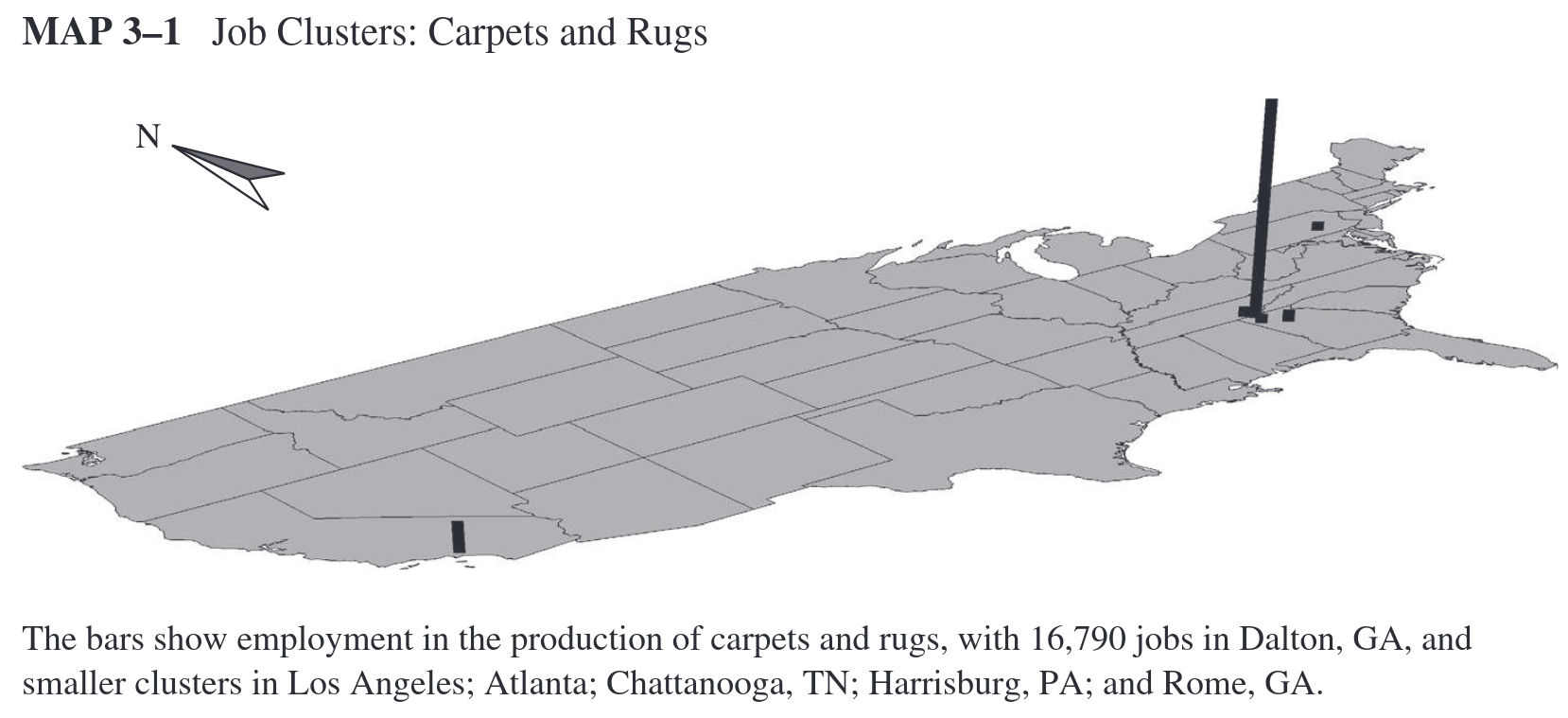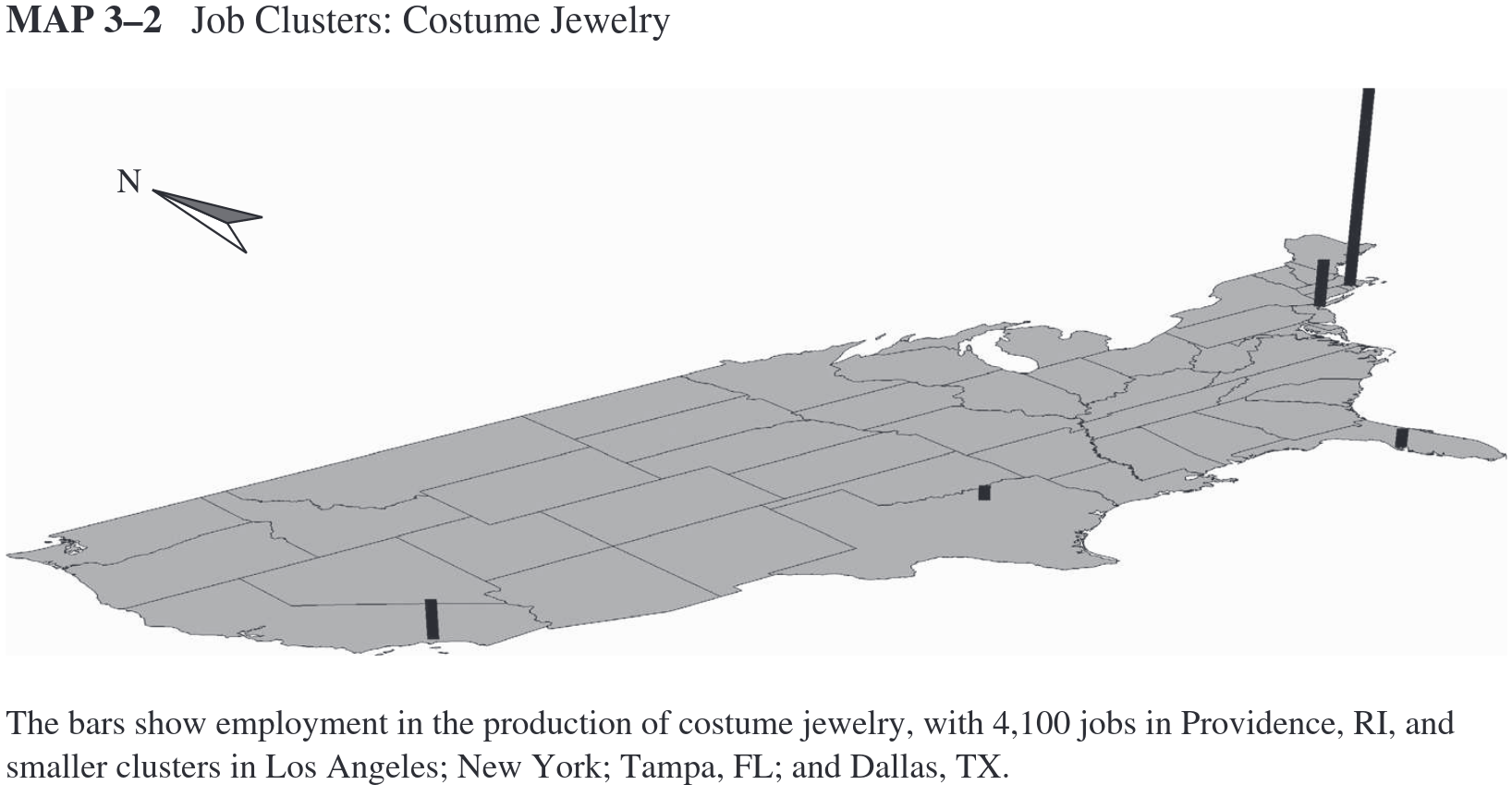class: center, middle, inverse, title-slide .title[ # Clustering, City Size, and Growth ] .subtitle[ ## EC330, Set 04 ] .author[ ### Andrew Dickinson ] .date[ ### Fall 2022 ] --- class: inverse, middle # Contents .hi-white[(i). Clustering] .hi-white[(ii). City size] .hi-white[(iii). Introduction to growth] --- # Housekeeping .hi[PS01 due on Sun, Oct 16th @ 11:59p] - We will be going over material for questions 4 & 5 today - Must be submitted on Canvas as a PDF -- <br> .hi[Reading] - Finish chapter 3 by end of this week --- # Last time: _Why do cities exist?_ We discussed some .hi[fundamentals] that lead existence, the .hi-blue[main takeaway:] .center[.hi[Incentives] must exist to justify higher land prices within a city] -- Two .hi[incentives:] - benefits of .hi-blue[centralized exchange] (trading cities) - benefits of .hi-green[centralized production] (factory cities) -- <br> .hi-blue[Other questions:] .center[.h[Why do cities grow beyond one factory?]] .center[.hi[Why are there differences in size across cities?]] .center[.hii[Where do cities emerge?]] --- class: inverse, middle # _Why do firms cluster?_ --- # _Why do firms cluster?_ Can we explain why there might be .hii[more than] one firm? - Which of the .h[5 axioms] is relevant to the number of firms within a city? -- .center[.hi[A5: _Competition generates zero economic profit_]] <br> -- Suppose a firm makes a .hi-blue[positive] economic profit. - then additional firms enter the market - `\(\Pi \rightarrow 0\)` -- Suppose a firm makes a .hi-red[negative] economic profit - then firms exit - `\(\Pi \rightarrow 0\)` --- name: zero_profit # Clustering example How many firms are in the cluster? <img src="04-growth_files/figure-html/cluster_graph-1.svg" style="display: block; margin: auto;" /> --- class: inverse, middle # Data --- # Data  --- name: cluster # Data  --- name: cluster # Data  -- Which axiom do these data relate to? -- .hi[A2: Self-reinforcing effects generate extreme outcomes] --- name: cluster # _Why do firms cluster?_ Why do .hi[within-industry] firms locate in same city? -- Why might profits .hi-blue[increase] as more firms cluster? <br> -- There exists some economic mechanisms that incentives .hi[within-industry] firms locate near one another - We categorize these mechanisms broadly as .hi[agglomeration economies] --- # Agglomeration .hi[Definition: Agglomeration Economies] -- _Benefits that come when firms and people locate near one another together in cities and industrial clusters_ -- > Agglomeration economies are the benefits that come when firms and people locate near one another together in cities and industrial clusters. These benefits all ultimately come from transport costs savings: the only real difference between a nearby firm and one across the continent is that it is easier to connect with a neighbor. Of course, transportation costs must be interpreted broadly, and they include the difficulties in exchanging goods, people, and ideas Source: [Ed. Glaeser](https://www.nber.org/chapters/c7977.pdf) --- class: inverse, middle # Benefits of agglomeration - .hi-white[(i) Sharing intermediate inputs] - .hi-white[(ii) Labor matching] - .hi-white[(iii) Knowledge spillovers] --- # Agglomeration - Sharing inputs Similar firms .hi[share inputs] to benefit from economies of scale -- Firms will share intermediate input suppliers to help .hi-red[reduce costs] - If costs .hi-red[go down], then `\(\Pi\)` goes .hi-blue[up] -- .hi[Example:] High tech firms - Rapidly changing goods that require sophisticated intermediate inputs - Electronic components and testing facilities - Firms rent capital/labor from intermediate firms -- <br> There exists an .hi[optimal cluster size] that maximizes input sharing benefits --- # Example - Sharing inputs --- # Agglomeration - Labor matching In models of labor markets, we typically assume that firms and workers match perfectly -- In the real world this is rarely the case - Firms and workers are .blue[not always perfectly matched] - Mismatches .hii[require training] to eliminate skill gap. .hi[Training is costly] - Think of the training you may need for your first job -- A large city will reduce these costs --- # Agglomeration - Labor matching Consider a labor pool of software programmers -- The skill sets of these programmers vary greatly - Coding languages: C, Javascript, Python, Rust, etc. - Programming tasks: graphics, AI/ML, OS development etc. -- Clustering .hi[attracts] more of the kind of workers they want -- Better for firm if they can find a worker to fill role immediately - Firms have higher probability in a cluster --- # Agglomeration - Knowledge spillovers .hi[Knowledge spillovers:] Exchange of ideas across individuals within a space -- - One of most important external benefit of a college campus (classroom) is the .hii[peer effects] -- .hi[Examples:] .pull-left[ - Graduate school - Jam sessions ] .pull-right[ - Attending seminars, workshops, and conferences ] -- Knowledge spillovers increase with more people and more knowledge -- `\(\Rightarrow\)` Knowledge Spillovers `\(\uparrow\)` `\(\longrightarrow\)` Productivity `\(\uparrow\)` -- .hi-blue[Urban settings:] Silicon Valley, Wall Street, etc. --- name: urban # Types of agglomeration Distinctions between two types of agglomeration -- .hi[(i) _Localization economies_] - Economic forces that incentivise clustering of firms .hi[within-industry] - Local to a particular industry - Examples: Silicon Valley; biopharmaceuticals -- .hii[(ii) _Urbanization economies_] - Economic forces that cause clustering of firms .hii[across-industry] - The presence of one firm attracts firms from different industries - Examples: Universities; corporate headquarters --- # Localization _.hi[Localization economy:]_ occurs when an increase in the size of an industry leads to an increase in productivity of production -- Evidence of higher .hi[labor productivity] - Higher output `\(\rightarrow\)` more productive workers (Henderson, 1986) - Tech workers benefit more from .hi[knowledge spillovers] than manufacturing (Mun & Huchinson, 1995) -- Evidence of higher .hi[rates of entry] - More firms are born where .hii[output is higher]; that is, where the industry is clustered (Carlton, 1986) --- # Urbanization _.hi[Urbanization economy:]_ occurs when .hii[growth] in population increases in productivity within the economy -- .hi[Sharing inputs:] banks, accountants, hotels, transportation -- .hi[Pooling:] workers move .hii[across-industry] - low demand to high demand -- .hi[Matching]: common skills across sectors (excel, for example) -- <br> Result in .hi[large and diverse] cities --- # Examples Two major examples of .hi[localization] & .hii[urbanization] economies: <br> .hi[(i) Silicon Valley] - firms locate close to share .hi-blue[high-skilled labor pool] despite high rents -- .hii[(ii) Los Angeles] - no super dominant industries - large, diverse, and growing workforce --- class: inverse, middle # City Size --- # City Size Why are some cities big while others are small? - We've shown why .hi[agglomeration] explain .hii[firms] clustering. - How does .hi[agglomeration] explain why .hii[people] cluster? -- <br> .hi[Agglomeration] increases productivity among its .hii[firms] and .hii[people] - leads to higher .hi[wages] in larger cities - higher wages incentivises migration decisions -- <br> Let's look at some .hi[data] of city populations in the US --- # City Size in the US <img src="04-growth_files/figure-html/zipf_one-1.svg" style="display: block; margin: auto;" /> -- A functional relationship exists between population and rank within a country --- # What Function? f(x) = 1/x <img src="04-growth_files/figure-html/zipf_two-1.svg" style="display: block; margin: auto;" /> --- # What Function? Zipf's law <img src="04-growth_files/figure-html/zipf_three-1.svg" style="display: block; margin: auto;" /> --- name: zipf # Size: Zipf's Law _Zipf's law_ of city size can be expressed as: `\begin{align*} R = \frac{C}{N} \end{align*}` .hi[Where:] - R represents a country's population rank - C represents a constant for a country/region - N represents the population level -- We can use this function to approximate city size based on rank --- # Zipf's Law: Example Assume the .hi[third] largest city in a region has .hii[200,000 people] ( `\(N\)` ) - Use _Zipf's law_ to estimate the population in the .hi[fifth-largest] city .hi[Two steps:] -- .hi[(i)] Calculate the constant `\(C\)`: `\begin{align*} 3 &= \frac{C}{200,000}\\ C &= 600,000 \end{align*}` -- .hi[(ii)] Use that info to calculate the population of the .hi[fifth-largest] city: `\begin{align*} 5 &= \frac{600,000}{Pop_5} \end{align*}` --- count: false # Zipf's Law: Example Assume the .hi[third] largest city in a region has .hii[200,000 people] ( `\(N\)` ) - Use _Zipf's law_ to estimate the population in the .hi[fifth-largest] city .hi[Two steps:] .hi[(i)] Calculate the constant `\(C\)`: `\begin{align*} 3 &= \frac{C}{200,000}\\ C &= 600,000 \end{align*}` .hi[(ii)] Use that info to calculate the population of the .hi[fifth-largest] city: `\begin{align*} 5 &= \frac{600,000}{Pop_5} \implies Pop_5 = 120,000 \end{align*}` --- # Zipf's Law: Intuition What does _Zipf's law_ describe about the relationship between .hi[rank] and .hi[city size]? -- <br> - a few cities will be big - there is a .hi[big drop] in population as rank increases - most low rank (high number) cities are .hi[pretty similar] in size --- # Example: Zipf's Law .hi[(i).] Assume that the Zipf's Law for cities is exactly true. If the .hi[fourth-largest] city in a region has .hii[2.5 million] people, how many people live in the region's .hi[largest] city? Show your work. <br> .hi[(ii).] How many people live in the region's .hi[tenth-largest] city? Show your work. --- # Primate Cities -- .hi-blue[Definition]: A .hi[primate city] is > A major city that works as the .hi[financial, political, and population center of a country] and is not rivaled in any of these aspects by any other city in that country. > "_at least twice as large as the next largest city and more than twice as significant."_ -- .hi[Examples]: .smallerer[ .pull-left[ .hi[City] - Seoul, South Korea - Santiago, Chile - Buenos Aires, Argentina - Lima, Peru ] ] .smallerer[ .pull-right[ .hi[Percent of Total Population] - 45.8% - 35.5% - 33.7% - 31.7% ] ] --- # Primate Cities What might generate primate cities? - Large .hi[economies of scale] in exchange - Inadequate .hii[transportation infrastructure] elsewhere -- .hi[Political factors:] - Easier for dictators to bribe, surveil populations of a primary city? - Capital cities with dictatorships are _45%_ larger than capital cities of other countries - Is this relationship .hi-blue[causal]? <sup>.hii[†]</sup> -- .footnote[ .hii[†] Maybe somebody does. But you definitely can't say from the 45% number. Much of modern econ is about figuring out when relationships _are_ causal. For a completely unrelated, but informative and entertaining example, see [this video](https://www.youtube.com/watch?v=6YrIDhaUQOE&t=133s). ] --- # Zipf's Law Why is _Zipf's Law_ generally accurate in describing city size? -- .hi[A2:] _.hi[Self-reinforcing effects] generate extreme outcomes_ "Winner take all" situations - policies, agglomeration, knowledge spillovers, etc. - Wages grow, workers in, firms enter, `\(\rightarrow\)` labor demand `\(\uparrow\)` `\(\rightarrow\)` wages grow -- What slows this process down? -- Increases in costs lead to .hi[diseconomies of scale] --- # Size Why do costs increase as workers move in? (Diseconomies of scale?) .h[(i)] .hi[Commute costs] - More people `\(\implies\)` more congestion (all else equal) -- .h[(ii)] .hi.green[Pollution] - More workers `\(\implies\)` more production `\(\implies\)` more .hi-green[pollution] -- .h[(iii)] .hii[Disease] - Early 1900's (US), living in a city `\(\rightarrow\)` life expectancy `\(\downarrow\)` 5 years - Now, the US's largest cities life expectancy exceeds the national average - Life expectancy in cities is, typically, lower than rural areas --- name: utility # Review: Utility Use it to .hi[model] the value individuals place on different city attributes .hi[Utility] is an abstract notion of peoples preferences -- .hi[Assumptions:] - .hi[(i)] Higher levels of utility are .hii[preferred] to lower levels. And more consumption is better than less - .hi[(ii)] .hi[_Ordinal, not cardinal._] Only the .hii[rank] matters, not the .hii[level] - .hi[(iii)] Marginal utility is diminishing (marginal value is diminishing) -- Similar to business' maximizing profits, individuals maximize utility --- # Modeling City Size <img src="04-growth_files/figure-html/u_f1-1.svg" style="display: block; margin: auto;" /> --- count: false # Modeling City Size <img src="04-growth_files/figure-html/u_f2-1.svg" style="display: block; margin: auto;" /> --- # Modeling City Size <img src="04-growth_files/figure-html/u_f3-1.svg" style="display: block; margin: auto;" /> --- name: eq # Locational Equilibrium .hi[Locational Equilibrium] occurs when utility levels (valuations) across cities are the same for all workers -- In a system of cities, .hi[migration] has a .hii[self-correcting] effect Locational Eq is stable when the utility curve is downward sloping - which implies cities tend to be too large rather than too small -- We usually do this by .hii[worker type] (demographic, income, education, etc) - For now, we will just consider the case when .hi[all workers are equivalent] --- # Locational Eq Graph <img src="04-growth_files/figure-html/u_loc-1.svg" style="display: block; margin: auto;" /> --- # Locational Eq: Implications _Why is this framework useful?_ - If utility really has this shape, what does this mean for policy? -- _Policies that impact the .hi[spatial distribution] of the population can have far flung effects on individuals it was not designed to impact, .hii[via migration]_ -- .hi-blue[Example:] - Local school quality improvements `\(\rightarrow\)` increased prices. Higher utility from school quality, lower from higher prices. Some people may be displaced? (Gentrification) -- - Net effect could be positive, but there will be winners and losers -- More on this later in the term when we study _.hii[place-based] policies_ --- class: inverse, middle # Growth --- name:growth_factors # Growth .hii[Econ in General]: Defined as an increase in per-capita income .hi[Urban Economics]: Defined as an increase .hi[_utility level_] of a typical resident -- Urban definition accounts for factors .hi[other than wage.] Such as: -- .hi[(i).] Increases in natural resources (.blue[gold is found under a city]) -- .hi[(ii).] Increases in physical capital (.blue[computers] 💻) -- .hi[(iii).] Increases in human capital (.blue[education] 🎓) -- .hi[(iv).] Technological progress (.blue[computers invented]) -- .hi[(v).] Agglomeration Economies 🏙 --- name:example # Example: Innovation .pull-left[ <img src="04-growth_files/figure-html/u_innov-1.svg" style="display: block; margin: auto;" /> ] .pull-right[ Initially: 2 cities, both with same utility curve Population each city: .orange[800k] (total pop, 1.6 m)] --- # Example: Innovation .pull-left[ <img src="04-growth_files/figure-html/u_innov2-1.svg" style="display: block; margin: auto;" /> ] .pull-right[ Productivity shock brings one city's curve up (due to say, higher wages) In the absence of migration, utility is now higher in the higher productivity city] --- # Example: Innovation .pull-left[ <img src="04-growth_files/figure-html/u_innov3-1.svg" style="display: block; margin: auto;" /> ] .pull-right[ .hi[Migration] induces workers toward the more productive city and away from the less productive city - .hii[New locational eq] ( `\(u^*\)` ): utility is equalized (higher than before). populations change ] -- .hi-blue[Note]: We are implicitly assuming - People are identical and perfectly mobile In real life high-skilled workers are far more mobile than low skilled --- # Example Recap <div style="text-align: left"> Consider two cities: each with an equilibrium population of 800k and the same utility per worker curve</div> - .hi[Innovation] (tech progress) in one city .blue[shifts utility per worker] curve up -- - Workers in the innovative city enjoy a higher level of utility - Workers migrate from the city that failed to innovate -- Eventually, a new equilibrium is reached where .hi[utility per worker] is the .hi[same across both cities] - Innovative city is larger --- name:economy_wide # Economy - Wide Growth .hi[Note]: If there is an .hii[innovation for the entire economy], then .hi[both cities] experience upward shift of utility curve - Since there is no utility gap, there is .hi[no migration] -- - Still economic growth, but city sizes stay the same --- # Table of Contents .pull-left[ ### Clustering .smallest[ 1. [Reasons for Firm Clustering](#cluster) 1. [Urbanizations vs Localization](#urban) ] ### City Size .smallest[ 1. [Zipf's Law](#zipf) 1. [Utility](#utility) 1. [Locational Eq](#eq) ] ] .pull-right[ ## Growth .smallest[ 1. [Growth factors](#growth_factors) 1. [Example](#example) 1. [Economy Wide Growth](#economy_wide) ] ] --- exclude:true <!-- --- --> <!-- exclude: true --> <!-- ```{R, generate pdfs, include = F} --> <!-- system("decktape remark 02_goodsmarket_part1.html 02_goodsmarket_part1.pdf --chrome-arg=--allow-file-access-from-files") --> <!-- ``` -->